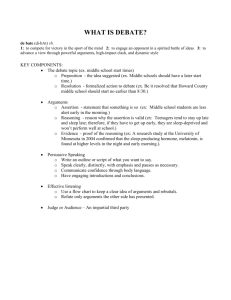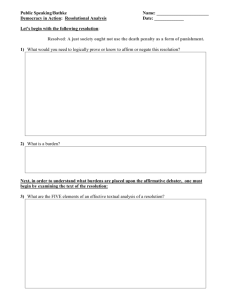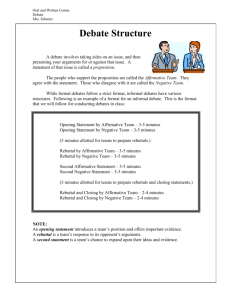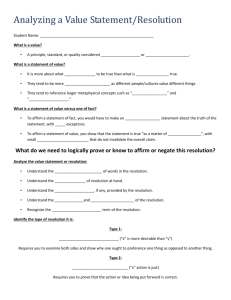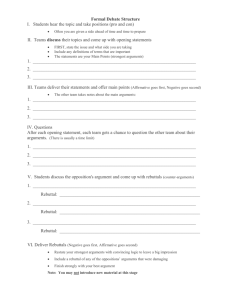Writing a Case: Planning and Topic Analysis
advertisement
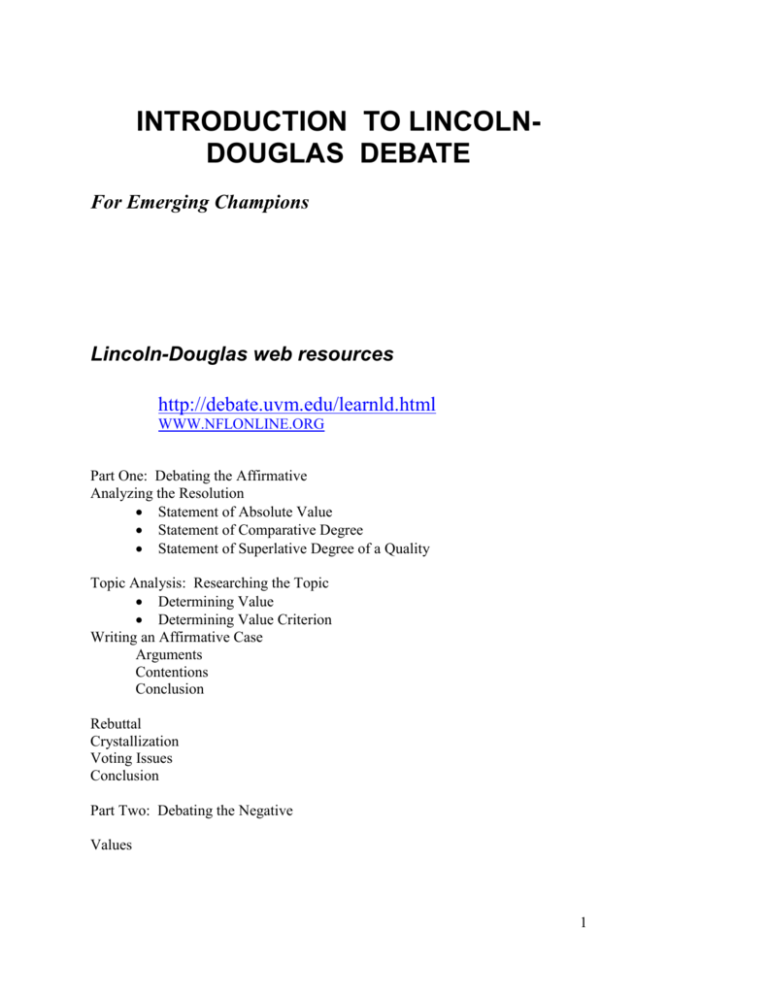
INTRODUCTION TO LINCOLNDOUGLAS DEBATE For Emerging Champions Lincoln-Douglas web resources http://debate.uvm.edu/learnld.html WWW.NFLONLINE.ORG Part One: Debating the Affirmative Analyzing the Resolution Statement of Absolute Value Statement of Comparative Degree Statement of Superlative Degree of a Quality Topic Analysis: Researching the Topic Determining Value Determining Value Criterion Writing an Affirmative Case Arguments Contentions Conclusion Rebuttal Crystallization Voting Issues Conclusion Part Two: Debating the Negative Values 1 PART ONE: Debating Affirmative in Lincoln/Douglas Debate This lesson assumes you are the affirmative debater which means you are defending the resolution. The resolution is a value statement that can be either affirmed or refutted. It may take more than one reading to absorb and internalize this information! Don’t be discouraged or intimidated! It just takes a bit of time to get through it – but it’s worth it! Debate is exciting once you get into the competitions! Assumptions: Basic Format Below is the basic formation for a round of Lincoln-Douglas Debate. You will need to memorize the order of events and the time/minutes for each. You must memorize the times, abbreviations and description of events in this chart. 2 LINCOLN-DOUGLAS ROUND Time Abbreviation (minutes) Speech Description 6 AC Affirmative Constructive The Affirmative reads a prewritten case that he or she has researched and composed. It should last the entire 6 minutes. 3 CX Cross Examination The Negative asks the Affirmative questions. 7 NC (1NR) Negative Constructive (and first negative Rebuttal) The Negative (almost always) reads a pre-written case and (almost always) moves on to address the Affirmative's case. 3 CX Cross Examination The Affirmative asks the Negative questions 1AR First Affirmative Rebuttal The Affirmative addresses both their opponent's arguments and their own NR (2NR) The Negative Rebuttal The Negative covers everything said in the round and gives the judge reasons to vote for them 2AR The Second Affirmative Rebuttal The Affirmative may either summarize the round or cover everything, but they always give reasons to vote for them 4 6 3 3 Analysis of a Lincoln-Douglas Debate Resolution Step one in preparing your case is to analyze the meaning of the resolution. There are three kinds of Lincoln Douglas Resolutions. Consider these because your approach or strategy in arguing the resolution is linked to the kind of resolution that you are facing. These are the three types of Lincoln Douglas resolutions: 1. Statement of Absolute Value Statement of Comparative Degree Statement of Superlative Degree of a Quality Statement of Absolute Value Absolute means unconditional or unqualified. Something is either True or False. An absolute value resolution is a true/false type of resolution. If something is “absolute” it is not viewed as partial or relative – it is completely unequivocal (indisputable, unambiguous). So there are no “gray” areas. These kinds of resolutions are very much true/false or black/white. Ex: Resolved: A person’s right to bear arms in the U.S. is justified. (so it is either justified or it is not justified. There is no “degree” or “variation” in this argument. There is no idea of one thing being “better” than the other.) If you are on the “affirmative” side – you must prove the resolution true. 2. Statement of Comparative Degree This type of resolution involves a values hierarchy – compares two values claiming that one is for one reason or another better than the other one. Ex: Resolved: Members of the U.S. Congress should value the national interest above their constituent’s interest when the two are in conflict. Here you are comparing the national interest with the constituent’s interest. Inherent in the wording of the resolution is a comparison! Remember, it is your responsibility as the affirmative debater to defend the resolution. (affirm = confirm, assert, verify) Ex: Resolved: A just social order ought to place the principle of equality above that of liberty. 4 Here you are again, faced with a Statement of Comparative Degree - you are comparing equality with liberty. It is your responsibility as the affirmative debater to defend the assigned value – in this case, equality. Prove that equality should be placed above liberty. Your proof MUST include a direct comparison of the two values. You don’t just talk about why equality is good. But why equality is better than liberty. That’s important. You don’t have to prove that the other value is bad nor do you have to prove that the other value is absolute. Only that equality is better. Never try to defend more than you need to defend. All you need to do is prove that YOUR value is better. (sometimes called proving the “value premise” better) 3. Statement of Superlative degree of a Quality This is a “good-better-best” type of scenario Ex: Resolved: National Security should be a nation’s highest priority To affirm this you must ask “Why should National Security be the highest value? Why is it superlative to everything else?” Do not assume the answer is obvious. You must consider what your opponent (the Negative debater) might propose as a superlative to this one. The opponent will argue a different superlative. They might, for example, state that Justice or Privacy is the highest value. So…as you analyze the resolution you first must: Determine what kind of resolution you are dealing with. Define every word in the resolution using several different dictionaries. Analyzing the resolution is the beginning of topic analysis. *** 5 Writing a Case: Planning and Topic Analysis 1. What are the values (ideas) in the resolution? Take it apart. Justice? Morality? National Interest? You have to analyze the topic – the resolution- and pull out the values in it. Resolved: Members of the U.S. Congress should value the national interest above their constituent’s interest when the two are in conflict. In topic analysis you must think: What are the reasons why this is true? You might say, it provides for defense, interstate commerce, or a stronger economy. TOPIC ANALYSIS realistically requires that you spend one or two days doing nothing but analyzing the topic and giving reasons why it is true. Think of potential arguments and write all of this down on paper. Example: Resolved: A victim’s deliberate use of deadly force is a just response to repeated domestic violence. In this resolution the word “just” is used. This asks whether or not the use of deadly force is justified when facing domestic violence. The “value premise” then, is justice. When you introduce your case you will state the resolution and the value premise. “I uphold that a victim’s deliberate use of deadly force is a just response to repeated domestic violence. I affirm a value premise of Justice. This is the proper value for the round because…..” In order to achieve Justice, we must adhere to the value criterion of the right to self defense…. The side that best upholds his/her value premise, and adequately defends it will win the debate. The “value criterion” is the means of achieving the value premise. The value criterion is the method by which you prove your value to be defended and affirmed. 6 2. ANTICIPATE : before you write the first word of a case – what will the opponent – the negative say and what are the values I will be able to defend and stand on? Especially as the debate gets further along. What are the values that I can pull out of the resolution and win with. The more you define the words in the resolution, the closer you will be to pulling out the value premise that you must defend. In the sample case I am giving you - you will see all of the Blocks (in the appendix) against the case. There is a Title or tag line, a source, and a summary of the rebuttal. Along the way, research and document the potential arguments the negative may have. You can win a case if you anticipate extensively what the opponent will argue and be ready to tear down their case. It is critical that you do this. Pre-empting: you are going to put into (build into) your affirmative case ideas that will clash with and undermine the negative’s case. Always consider what the negatives are going to say. Organize your files by arguments so you can find them quickly depending upon the direction the negative takes. Let’s go back to this one: Resolved: National Security should be a nation’s highest priority Why? What value is emerging here? Security? Safety? Is it more important than Liberty? Equality? Privacy? (Remember the movie “V for Vendetta”? The nation gave up their liberty for security – and became a Fascist state! ) You must prove your position true. You cannot win by just proving the negative false. Have I assumed my affirmative burdens? You must prove your position true with factual evidence. Affirmative has the burden of proof. Note: If the Resolution says that the Government has the responsibility to do xyz then you cannot then prove that “society” or some other entity has the responsibility to do xyz. Read the resolution very carefully. 3. The Affirmative Constructive Speech (1AC) The affirmative’s speech is first. Your complete case is presented here. All of your key arguments, contentions and definitions are presented in this six minute speech. You cannot add new arguments in rebuttals. Every reason for which you think we must adopt this resolution must be in the constructive speech. It is the entire basis of your case. Ex: Resolved: National Security should be a nation’s highest priority. 7 If you state in the Affirmative Constructive Speech (1 AC) that the reason for this is national defense – you cannot later in a rebuttal, state that this is also necessary for our economy. You cannot change position! No new arguments can be stated outside of the first affirmative constructive speech. I repeat! All arguments MUST be in the constructive speech. Rebuttals and conclusions reinforce – do not add new arguments. Exercise Try to explain what type each resolution is below. Then determine a “value premise” for each. In other words, what value is being protected? Then go a step further and decide what the “value criterion” should be. 1. Resolved: It is morally permissible to kill one innocent person to save the lives of more innocent persons. 2. Resolved: In a democratic society, felons ought to retain the right to vote. 3. Resolved: The United States ought to submit to the jurisdiction of an international court designed to prosecute crimes against humanity. 4. Resolved: In the United States, plea bargaining in exchange for testimony is unjust. Answers and details about each of the resolutions above are found at: http://www.nflonline.org/Main/LincolnDouglas Click on the blue link above the resolution for a briefing about how to present the case and what value premise best serves the resolution! *** 8
